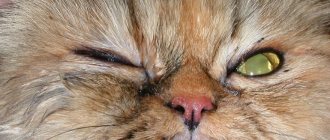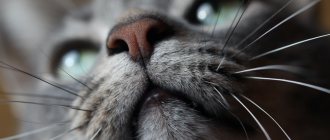Neoplasms on the body of cats require attention, as they can threaten the pet’s life. A hard lump on a cat’s neck may turn out to be an ordinary wen, which does not pose a danger if removed in a timely manner, but may also indicate the occurrence of malignant processes.
It is impossible to independently diagnose the nature of the neoplasm without a biopsy, so the first thing a loving owner should do when discovering a growth is to show the pet to a specialist.
Risk factors
In the vast majority of cases, owners of older animals encounter neoplasms on the withers and neck of cats. The appearance of soft cones and balls is due to the natural aging of the animal’s body. Risk factors for this:
- The pet is over 8 years old;
- Endocrine disorders;
- Obesity;
- Presence of parasites.
Only a veterinarian can accurately identify the nature of the lump, the cause of its appearance and suggest treatment methods. Self-medication in the presence of formations in pets is not allowed.
How long do cats with tumors live?
Unfortunately, no doctor in the world can give an accurate prognosis; it depends on many factors, as well as on how aggressively the tumor develops. It happens that, despite all the efforts made by the owner, the animal dies after a month. This could be due to a variety of factors. Starting from inappropriate treatment and ending with actively growing metastases. Try to regularly donate blood for analysis and carry out all the tests that the doctor prescribes for your pet. If he is scheduled for another study, this does not mean that they want to scam you out of money. The doctor wants to help the pet and does everything in his power. And without traditional research it is almost impossible to do this, because a visual inspection alone is not enough. We still need to examine the animal and do everything to ensure that the treatment matches the disease. Be attentive to your pets and take them for a preventive examination at YA-VET!
Abscess on the neck
A lump on your cat's neck may be an abscess. This is a cavity filled with pus. It appears at the sites of wounds and injuries, and may be a consequence of skin irritation by parasites, in response to which the pet scratched the wound.
Abscess symptoms:
- Homogeneous structure of the neoplasm.
- Redness and increased temperature of the skin around the affected area.
- Pain when pressing.
With an abscess, the cat is constantly trying to reach the tumor. If she can't scratch her neck with her paw, she starts rubbing herself against the furniture. Thus, the animal tries to get rid of the annoying lump on its own.
Since an abscess is a purulent inflammation, a general deterioration in the pet’s well-being is possible. The cat may become lethargic or, on the contrary, irritated and refuse to be handled.
Only a veterinarian can quickly relieve an animal of discomfort. The abscess is opened with a scalpel, then the cavity filled with pus is cleaned out and the wound is treated with antiseptic. If necessary, the doctor may apply stitches and prescribe antibiotics to prevent the inflammation from reoccurring.
We recommend the article: Why does a cat not open one eye?
An abscess can open on its own, but this is dangerous for the animal’s health. The cat can lick off the purulent contents, but there remains a risk of re-infection of the resulting wound.
Prevention measures
If various microtraumas or bruises occur on the animal’s body, it is necessary to treat the wound, even the smallest scratch. Through an open wound, microorganisms enter the bloodstream, which can lead to inflammation, an abscess, or inflammation of the lymph nodes.
It is necessary to periodically wash the animal's fur and skin so that the pores on the cat's skin do not become clogged.
Any formation is stressful for the cat’s body and the owner’s nerves; in no case should you self-medicate, and immediately take your pet to the doctor - only the doctor will determine the type of tumor and make the correct diagnosis.
Attention to the cat’s hygiene, to changing its behavior, and timely contacting a veterinarian will save the animal from terrible diagnoses, and the owner’s nerves will be in order. Share with friends:
Lump on a cat's neck photo
Hygroma
Or a synovial cyst is a swelling of tissue with saturation with serous fluid.
It looks like a painless swelling with fluid inside, but if an infection joins it, ulcerations and discharge appear. And when it grows to a large size, it can interfere and hurt when moving.
The veterinarian may prescribe removal of the contents of the cyst and the introduction of anti-inflammatory drugs in its place, but surgery is rare.
Malignant neoplasms
A soft lump on a pet's neck can pose a threat to the cat's life. In older animals, the appearance of a neoplasm may indicate oncology.
Malignant lumps do not have specific symptoms; only a specialist can make a diagnosis. As a rule, with cancer, a cat feels unwell and lacks strength, refuses to eat, and begins to lose weight. Since these symptoms are common to other diseases, you should immediately show the animal to a specialist.
To make a diagnosis, the doctor will do an X-ray or MRI. If a malignant tumor is suspected, a biopsy is performed - removal of particles of the tumor for the purpose of histological examination of tissue cells. Based on the results of histology, a decision is made on further treatment. The lump must be completely removed, and the animal is prescribed a course of chemotherapy.
Hormonal disorders and breast cancer
The second reason for the formation of lumps in a dog may be the development of a mammary tumor. Unlike mastopathy, tumors usually have focal localization. There are several causes of breast tumors. But the main predictive factors are the following: - constantly recurring estrus - long-term absence of mating during the reproductive period - hereditary factor - long-term use of hormonal drugs
Tumors on the mammary glands can be either benign or malignant. But the percentage of benign formations is very small. Thus, 9 out of 10 neoplasms on the mammary glands in cats are cancer. Tumors can be easily detected by simply palpating the surface of the mammary glands. You may notice the appearance of lumps and nodules in your dog, which may increase in size if no measures are taken. As a result, the tumor can grow and develop into a malignant pathological form.
At first, the tumor is usually quite small in size and rarely grows, but the tumor can abruptly move into the first stage of the disease after false pregnancy. The number and size of the bumps may increase, and the surface becomes bumpy.
If you trust statistics, then a common cause of death for most animals in the second half of life is oncology in cats and dogs . It firmly holds second place among the causes of overall mortality. However, as in humans, if a tumor and lump in a cat are detected in a timely manner, then surgical treatment in the early stages usually leads to a complete recovery. If you do not seek help from a veterinarian in time, the tumor will grow and cause complications. Enlarged lymph nodes may be noted. At the last stage, the tumor metastasizes to other organs. At this stage of the disease, the prognosis is unfavorable with any type of treatment. Frequently asked veterinarian questions
If a cat has a small and single lump near the nipple, should it be taken to the vet? Naturally. Even the smallest neoplasm can become the beginning of a malignant tumor. It is easiest to take action at the onset of the disease.
If the mammary gland is swollen over the entire surface, but the cat feels well and eats, then should you worry? Swelling may be a sign of an unfavorable process. To find out exactly the nature of the process, you need to contact a veterinary clinic.
The cat has lumps all over the mammary gland. The doctor suggested removing the entire gland. Is this dangerous for the dog? There are no simple operations. Especially oncological ones. The intervention proposed to you should be carried out by a veterinarian with experience in such interventions. After surgery, a histological examination is required. And, if necessary, adjuvant chemotherapy.
Incipient breast tumor.
Developed breast tumor.
As soon as a lump has been detected in a cat or dog, or if there are indirect signs that allow one to suspect cancer, we recommend that you consult a veterinarian without the slightest delay.
Unfortunately, this problem cannot be solved at home. We have all the necessary conditions for the examination and treatment of cancer in dogs and cats.
Breast tumor. Despite its small size, this is already a neglected case. Metastases.
Lipomas in cats
If a cat has a soft lump on its neck that easily rolls under your fingers and does not cause discomfort to the pet, a lipoma or wen is a possible cause.
The reason for the appearance of such seals is the peculiarity of the functioning of the animal’s sebaceous glands. The formation of lipomas is often associated with endocrine disorders and obesity in older animals.
Wen themselves are not dangerous, but must be removed, especially if they are located on the pet’s neck or head. The fact is that a benign lipoma can begin to degenerate into cancer with age, so veterinarians recommend removing lipomas in a timely manner.
Features of operations to remove such tumors
Such formations, first of all, should not be enucleated, that is, only the tumor itself should not be removed. According to the rules of oncological surgery, they must be removed, taking into account the surrounding tissues, taking into account their anatomical location, taking into account the blood and lymph circulation in this area. This means that it is better to contact a qualified oncologist or surgeon to ensure that this formation is excised correctly and to reduce the likelihood of relapse and further spread of the tumor.
Surgical intervention for tumors in animals is not considered in terms of simple surgical excision alone. Such important points are assessed as, firstly, whether this excision will improve the quality of life of the animal, and secondly, whether the animal will continue to live adequately, whether it will be mobile after the operation and how long the rehabilitation period will be. All these points are taken into account by the oncologist surgeon.
If he considers the intervention appropriate, if there is a possibility that this intervention will be successful, it is carried out. If this intervention is crippling, if it does not improve the quality of life of the animal, or if the prognosis is unfavorable, then there is no question of surgery.
Insect bite
No, not butterflies. Painful swelling can only be caused by the bite of stinging insects!
Remove the sting with tweezers, rinse with a soda solution (a teaspoon per glass of water) and apply a cold compress to relieve swelling.
To prevent allergies, give ¼ tablet of Tavegil or Suprastin twice a day, and if the condition worsens, go straight to the clinic, and even more so if there are a lot of bites, because then death is not far away.
Furuncle
This is not just an abscess - inflammation of the epithelium, but a disease (in acute or mild form) caused by decreased immunity and focal damage to the hair follicle. It is purulent and necrotic in nature, caused by white or aureus staphylococcus, and begins with a red tubercle:
Gradually, the sore increases, fills with pus, becomes painful, body temperature rises, apathy and loss of appetite are possible. The lesions affect some or all parts of the body, or isolated ones.
Under the skin, the pus is located, as it were, in a “vessel” that restrains the boundaries of inflammation, and after “ripening” one (or several) gray dots will be visible from above - the rod.
Do not squeeze out the boil! Otherwise, the pus will spill over the adjacent tissues.
The veterinary clinic will do everything you need, and in the case of a chronic form, they will prescribe antibiotics.
Keep a sick animal especially clean by placing disposable diapers on top of the bedding every day. Don't bathe! Trim the fur from the site of inflammation, apply ichthyol ointment or Vishnevsky, wipe with alcohol while changing the compress, give an anesthetic. In case of spontaneous opening of the sore, clean it as much as possible from pus (do not press!) and reapply a bandage with ointment, changing it every 4-6 hours until the wound is completely cleansed.











